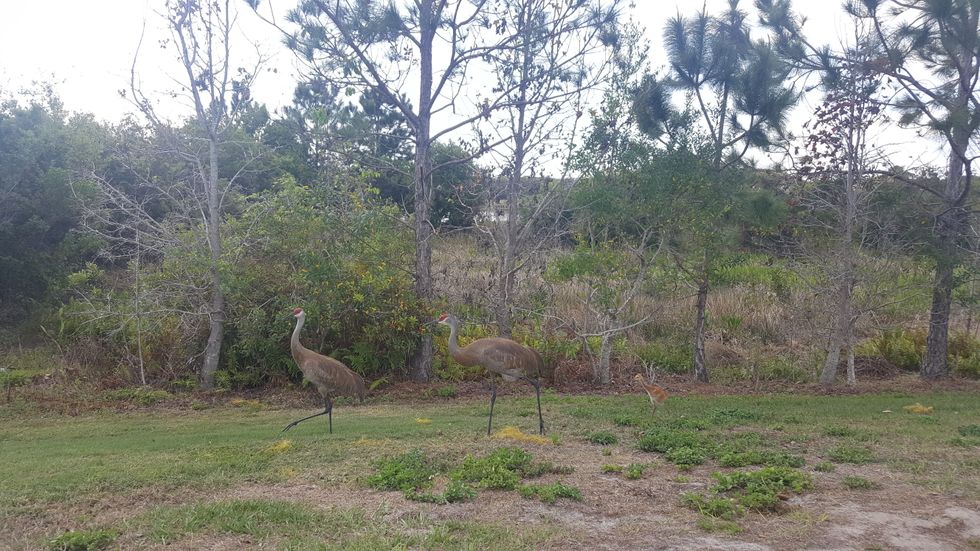I remember the first time I heard that distinct warbling call. A clear November day, the skies were deep blue and the only clouds were a few very high wispy ones. I heard the warbling while working with my dad outside. I looked around to see where the sound was coming from and couldn't see anything. Later I heard the calls again so I looked, this time I spotted a flock of birds so high in the sky they were barely visible. Their legs were stretched out long meaning the probably weren't geese. They flew like cranes and herons I had seen, but they were in a large flock and at higher altitudes than any crane I had seen. I had never heard any birds like it. I could hear them so easily, their calls carried far and echoed even when they were just specks in the sky. When I inspected the flock more closely, I realized there were dozens of birds. I looked harder and saw another flock higher than that one. From all around they seemed to be joining together until their flock formed into hundreds. I had never seen so many birds migrating together.
I was accustomed to seeing flocks of Canadian geese migrate, most of them, however, had migrated already. Most of the leaves had fallen from the trees and the weather was getting colder, but here these birds were migrating late in the season, flying in flocks of hundreds a mile in the sky.
I looked up cranes to identify that warbling call. I did not get a close look at the birds but I wouldn't forget that call anywhere. I found whooping cranes, they also have a unique call but I find their call resembles more of a honking like geese. Then I found a video of thousands of migrating birds landing in Nebraska all warbling. They sounded exactly like the birds I had seen but louder since they were up close. They were tall birds standing three or four feet high which explains why I could see them flying so high. They were called sandhill cranes and our North Chicago suburbs were lucky to be right in the middle of their migration path.
I only heard their warbling for a few days, then it stopped; they were all gone. The weather quickly grew colder, the winter came and went. Then I was working with my dad again outside in March. Most of the birds had not yet returned. The weather was barely beginning to warm, all the trees were still bare, and only a few crocuses were peeking from the ground. While working, I heard the familiar warbling call. Closer and louder than I remember before. I looked and saw a small flock of birds with their long legs and a massive wingspan of six feet, the magnificent sandhill cranes. I pointed them out to my dad who was equally fascinated and we watched as they flew overhead. I watched until I could see them no longer, then more came.
Sometimes you would hear the warbling but strain your eyes not seeing anything. Then you would see them faintly, the sun illuminating them when they turned at the right angle. They would circle as more and more flocks from all directions joined. These birds loved traveling together. Sometimes you would look your hardest and not see anything because they would be above the clouds. Birds, flying above the clouds, I never knew it was possible. Sandhill cranes migrate around 5,000 feet but are also experts at catching thermals, rising columns of warm air that carry them to heights of 12,000 feet. Maybe that is what the birds were doing when I saw them circling so high.
I knew what sandhill cranes looked like up close from the video I saw but had never seen it for myself. One day we were driving through the northern suburbs where more fields and rural land was common. We drove past a field where the corn had already been harvested and I saw two very tall beige cranes. Their bodies were big and curved they reminded me of emus. They had distinct red patches on their faces. They were so large I marveled that they could fly so well. On the ground, they remain in breeding pairs rather than the massive flocks that they form when they migrate.
Ever since those first few times of seeing sandhill cranes, I would look forward to their migration every spring and fall and occasionally spot breeding pairs at other times. In the summer of 2014, my dad and I were working on a house together. As we carried our paint buckets and tools to the back deck we spotted a lone sandhill crane standing in the backyard. We quietly approached and he let us get within 10 feet. I had never stood so close to one, it was nearly as tall as me. It let out a few calls that sounded funny on their own. It was still a warbling call but different from when you hear whole flocks making the noise. He roamed the yard for a little then let out another call and beat his massive wings and took off with graceful ease.

After moving to Florida, one time we were hanging out with our friends and near the playground was two adult sandhill cranes and a baby. The baby was small and orange. I had never seen a baby sandhill crane before, it looked more like a little chicken than a sandhill crane, but it stood proudly on its long legs knowing exactly what kind of bird it was. They stood grooming themselves and nibbling on grass bending their long necks with ease. They did not mind my presence; I sat near them and watched them for a long while. I am privileged to have been so close to such magnificent birds, as graceful and spectacular on the ground as they are miles in the sky.


















